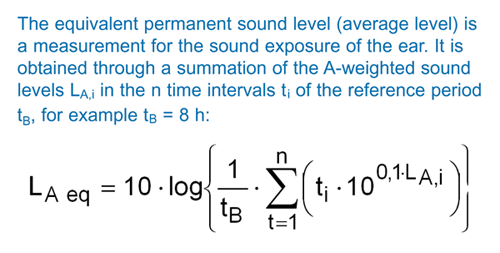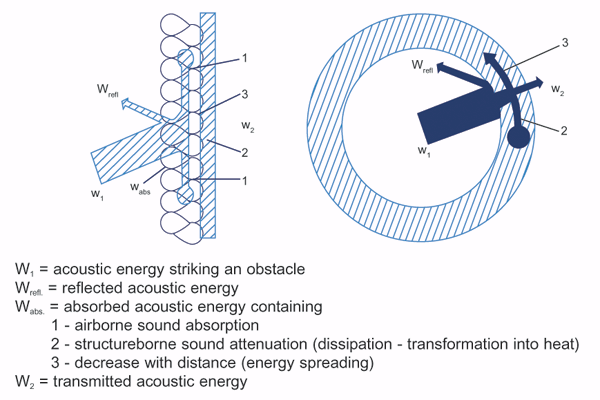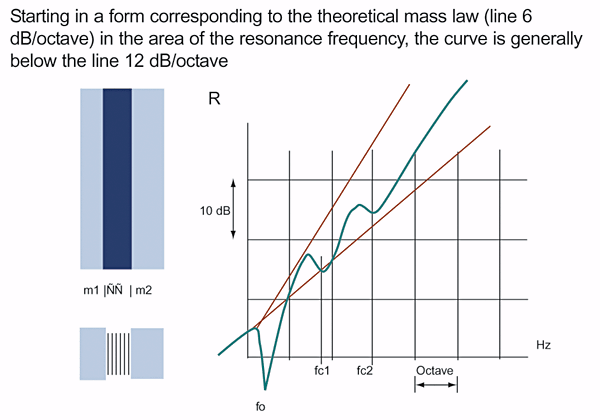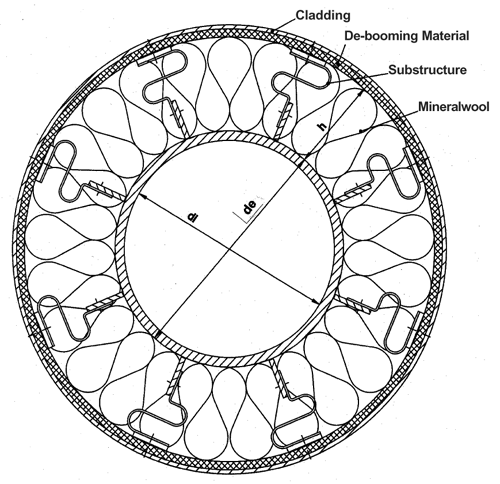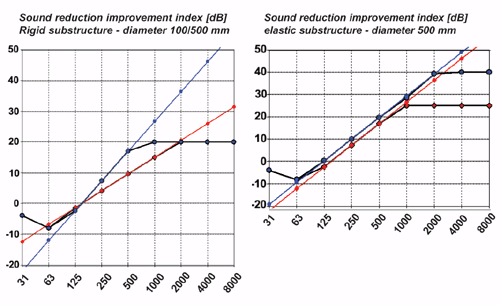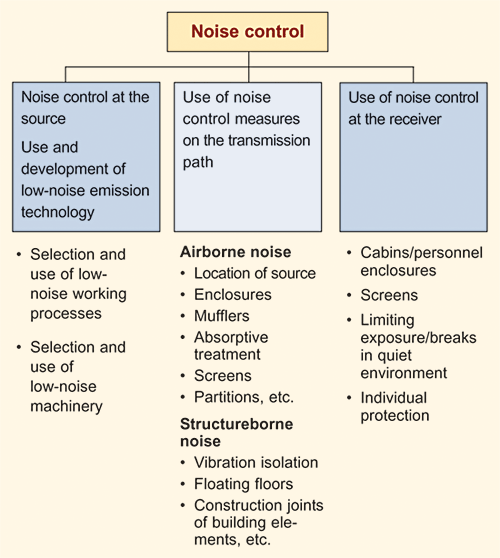Tackling Environmental Pollution
Not long ago, Europe began working to increase public awareness of environmental hazards to health and comfort, with a focus
on “environmental pollution” caused by noise. Several European directives are now in place, with an aim to reduce unnecessary
noise and protect the human ear where exposure to noise is unavoidable (e.g., in workshops, near busy roads and airfields,
etc.).
To date, only limited research has been conducted on how best to deal with the problems that result from noise. The
Féderation Européenne des Syndicates d’Entreprises d’Isolation (FESI, translated as the European Federation of
Associations of Insulation Contractors), the European partner organization to the National Insulation Association (NIA), has
produced a series of documents addressing both, the theoretical physical background of the production and propagation of
noise, as well as the practical conclusions to be drawn for the task of “sound insulation” through absorption and
attenuation.
This began with a European directive in 1986 (86/188/EWG), which stated that the limit value of noise exposure for the ear is
at an equivalent continuous sound level of Leq = 85 dB(A) over the average 8-hour work day. This leads to a noise-induced
hearing loss of 5 percent in exposed subjects after 10 years. If this level of hearing loss is sustained over the duration of
an individual’s working life (e.g., 40 years), the total loss amounts to 20 percent on average.
This observation sparked an investigation into what makes up Leq, the equivalent continuous sound level. However, because its
physical expression (Figure 1) is not particularly illuminating for the average insulation practitioner, FESI opted to give
more practical explanations and advice for how to deal with environmental noise.
Three of the following documents on this subject were presented at NIA’s 50th Annual Convention held in Las Vegas, March
2005; two are scheduled for completion in 2006.
A2: “Basics of Acoustics” (available May 2000)
A3: “Product Characteristics—Acoustic Insulation, Absorption, Attenuation” (available April 2002; revised editionavailable September 2002)
A4: “Acoustics in Buildings” (available October 2006)
A5:“Acoustics in Rooms” (available May 2006)
A6:“Industrial Acoustics” (available May 2004)
Documents A2, A3 and A6 had been completed before the convention and were outlined in the presentation. Currently,
document A5 is nearly complete, and a first draft of A4 (in French) has been written. The three completed documents are
available from NIA, and it is anticipated that the remaining papers will be presented at NIA’s 2007 convention.
This series provides practical advice from a starting point of “principal considerations” (e.g., What sort of noise
protection can be expected from a wall composed of the following elements?). These principles—”fundamental truths as
bases for reasoning”—are found in document A2. Document A6 details the principles of sound propagation in industrial
environments and places.
Basics of Acoustics
This article is not intended solely for the insulation practitioner. Readers need not understand or be able to draw
conclusions from the subsequent documents. Rather, this is for those who want to learn the physical reasons underlying the
practical advice given in the manuals.
The document on principles (“Basics of Acoustics,” A2, quoted above) first gives a rationale for undertaking this endeavor
and then briefly explains the physical laws that govern sound production and propagation:
Since the mid-1900s, the steadily increasing population, rushing motorization, and the advancing mechanization of workplaces,
in households and in leisure activities have led to a continuous increase of exposure to general noise. The consequences are
concentration and sleep disturbances; damage to the autonomic nervous system, which can result in stomach, heart and
circulatory debilities; and noise deafness, which has been recognized as the number-one occupational disease.
Acoustics has been defined as the science of sound and its influence on human beings. For sound to travel from its source to
the human ear, it must be able to pass through air or other media. In the absence of any medium (vacuum), sound propagation
is impossible.
As sound pressure and frequency levels increase, so does the need to protect the human ear, where hearing ranges from “just
audible” to “painful.” Figure 2 lists the practical sources of noise that are commonly associated with these sound pressure
levels, from the peaceful rustle of leaves (just audible) to the painfully loud launch of a rocket (painful).
However, the sound pressure level has no direct linear relation to the irritation that the sound causes for human beings.
Here, the “physiological-psychological” effect must also be considered, as illustrated in Figure 3.
From these very fundamental considerations, the document goes on to detail the influence of the source geometry on sound
pressure change and sound propagation (Figure 4), and then to give the equations for sound propagation from different
sources, respectively, in reverberation rooms. (Figure 5). All in all, document A2 contains 38 of these equations.
Acoustic Insulation, Absorption and Attenuation
Document A3, “Product Characteristics—Acoustic Insulation, Absorption, Attenuation,” is a tool much more closely geared
toward the day-to-day needs of the practitioner. The focus is on the phenomena (e.g., distance) and material barriers (e.g.,
walls, screens, etc.) that diminish the sound pressure level of the noise propagating from a source, and how they make this
happen.
For instance, this document details the sound-absorbing qualities of “different types of walls” and what can be done to
reduce “structure-borne” and “airborne” sound. It also outlines the influence of material obstacles on the propagation of
sound. Figure 6 illustrates this, showing acoustic energy striking an obstacle and being reflected, absorbed and
transmitted.
This leads to a discussion of the sound-attenuation qualities of single- and double-layer walls, detailing the
sound-attenuation qualities of pipe insulations against the flow noise of media. The document explains the “law of mass”
equation, which predicts that each time the frequency of measurement or the mass per unit area of a single layer wall is
doubled, the transmission loss increases by about 6 dB.
Double-layer walls are discussed in some detail, as they constitute—in practical building applications—the solution of
choice when it comes to “sound insulating” rooms against each other. (Figure 7)
These brief explanations of the physical principles underlying propagation (e.g., the construction of barriers to sound
propagation) have practical implications, such as the sound reduction to be expected for different types of walls. There is a
clear correlation between total surface mass and the sound-reduction results. The sound-reduction quality of a double-layer
wall is increased considerably when a layer of mineral wool is inserted between the two walls. Although this does not
increase the total surface mass to a measurable degree, it does increase the sound-reduction properties.
The principles governing the sound-reduction qualities of double-layer walls, with or without an intermediate layer of
mineral wool, also govern the sound-reduction performance of insulated pipes: The pipe wall is the “first partition,” the
cladding is the “second partition” and the intermediate layer is the mineral-wool insulation. (Figure 8)
Normally, the two partitions are mounted on one frame, since the distancers connect them. Figure 8 shows how using a flexible
substructure between the pipe wall and cladding can diminish this “one-frame effect.” It also demonstrates a method for
increasing total surface mass by increasing the surface mass of the second partition-the cladding-with an added “de-booming
layer” on the inside of the sheet metal. This de-booming layer not only increases the surface mass of the cladding but also
lowers the propagation of the structure-borne sound into the cladding and the airborne sound outward of the cladding.
After traveling through the solid structure, the structure-borne sound is transmitted to the surrounding air, where it
excites a surface able to radiate like a loudspeaker membrane. In Figure 8, the “membrane” is the outer surface of the
cladding. If this transmission to the air around the structure did not occur, the human ear could not hear structure-borne
sound.
It is somewhat self-evident that the smaller the vibrating surface, the smaller the sound level. However, it is less obvious
that an increase in the rigidity of the transmitting structure may also increase the radiation efficiency and thereby the
sound level. This is the reason for the flexible substructure of pipe insulation claddings, where an attenuation of the flow
noise through the pipe is also a consideration.
Of course, as with all sound propagation and sound insulation phenomena, this depends very much on the frequency of the
sound. Figure 9 illustrates the sound-reduction qualities of pipe insulation with claddings and rigid and elastic
substructures, respectively, and the dependence on frequency.
Industrial Acoustics
The last of the three completed documents from the FESI acoustic documentation series is document A6, “Industrial Acoustics.”
This paper focuses on applying the information from documents A2 and A3 to industrial working environments. The document
begins with another short discussion of the principles of sound propagation indoors and out in the open and then concentrates
on “noise control.”
Distance from the noise source is a key consideration because the sound-pressure level decreases by 6 dB per doubling of the
distance between the source of sound and the listener. One important consideration for this “decrease by distance” is the
question of whether the propagation is spherical, hemispherical or quarter-spherical. In the equations shown in Figure 10, Lp
is the sound-pressure level and r is the distance from the source. The increase in sound-pressure level decrease per distance
is dependent on the pressure of sound-reflecting surfaces near the source.
In addition, the principles of industrial noise control are outlined in Figure 11, followed by practical advice on how to
organize and execute noise-control measures in an industrial environment.
This short overview of the content of these three papers is not an attempt at a full report on practical acoustical problems
and their solutions, as explained in the documents. Instead, the aim of this article is to indicate the ways in which
problems can be addressed and to relay the practical advice given in the documents regarding solutions for these problems in
insulators’ daily work.

